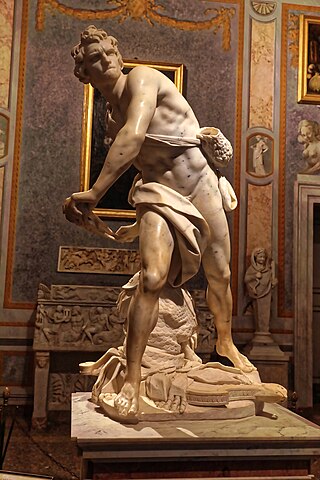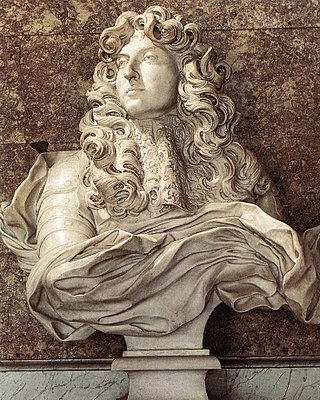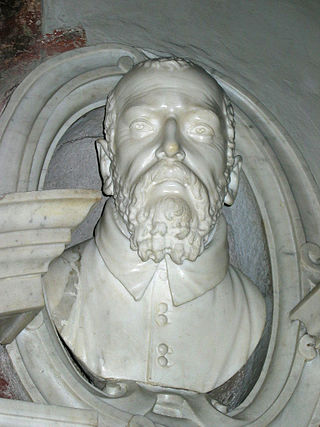
Gian LorenzoBernini was an Italian sculptor and architect. While a major figure in the world of architecture, he was more prominently the leading sculptor of his age, credited with creating the Baroque style of sculpture.

David is a life-size marble sculpture by Gian Lorenzo Bernini. The sculpture was one of many commissions to decorate the villa of Bernini's patron Cardinal Scipione Borghese – where it still resides today, as part of the Galleria Borghese. It was completed in the course of eight months from 1623 to 1624.

Neptune and Triton is an early sculpture by the Italian artist Gian Lorenzo Bernini. It is housed in the Victoria and Albert Museum of London and was executed c. 1622–1623. Carved from marble, it stands 182.2 cm (71.7 in) in height.

Charity with Four Children is a sculpture by the Italian artist Gian Lorenzo Bernini. Executed between 1627 and 1628, the work is housed in the Vatican Museums in Vatican City. The small terracotta sculpture represents Charity breast-feeding a child, with three other children playing. There is an imprint of Bernini's thumbprint in the clay.

François Duquesnoy or Frans Duquesnoy was a Flemish Baroque sculptor who was active in Rome for most of his career, where he was known as Il Fiammingo. His idealized representations represented a quieter and more restrained version of Italian baroque sculpture, and are often contrasted with the more dramatic and emotional character of Bernini's works, while his style shows a great affinity to Algardi's sculptures.

Apollo and Daphne is a life-sized marble sculpture by the Italian artist Gian Lorenzo Bernini, which was executed between 1622 and 1625. It is regarded as one of the artistic marvels of the Baroque age. The statue is housed in the Galleria Borghese in Rome, along with several other examples of the artist's most important early works. The sculpture depicts the climax of the story of Apollo and Daphne, as written in Ovid's Metamorphoses, wherein the nymph Daphne escapes Apollo's advances by transforming into a laurel tree.

Blessed Ludovica Albertoni is a funerary monument by the Italian Baroque artist Gian Lorenzo Bernini. The Trastevere sculpture is located in the specially designed Altieri Chapel in the Church of San Francesco a Ripa in Rome, Italy. Bernini started the project in 1671, but his work on two other major works—The Tomb of Pope Alexander VII and the Altar of the Blessed Sacrament in St. Peter's Basilica—delayed his work on the funerary monument. Bernini completed the sculpture in 1674; it was installed by 31 August 1674.

The Rape of Proserpina, more accurately translated as The Abduction of Proserpina, is a large Baroque marble group sculpture by Italian artist Gian Lorenzo Bernini, executed between 1621 and 1622, when Bernini's career was in its early stage. The group, finished when Bernini was just 23 years old, depicts the abduction of Proserpina, who is seized and taken to the underworld by the god Pluto. It features Pluto holding Proserpina aloft, and a Cerberus to symbolize the border into the underworld that Pluto carries Proserpina into.

The Goat Amalthea with the Infant Jupiter and a Faun is the earliest known work by the Italian artist Gian Lorenzo Bernini. Produced sometime between 1609 and 1615, the sculpture is now in the Borghese Collection at the Galleria Borghese in Rome.
Olga Raggio was an art historian and curator who worked with the Metropolitan Museum of Art for over 60 years, and discovered the 'lost' bust of Cosimo I de' Medici by Bartolommeo Bandinelli.

The Martyrdom of Saint Lawrence is an early sculpture by the Italian artist Gian Lorenzo Bernini. It shows the saint at the moment of his martyrdom, being burnt alive on a gridiron. According to Bernini's biographer, Filippo Baldinucci, the sculpture was completed when Bernini was 15 years old, implying that it was finished in the year 1614. Other historians have dated the sculpture between 1615 and 1618. A date of 1617 seems most likely. It is less than life-size in dimensions, measuring 108 by 66 cm.

The Bust of Louis XIV is a marble portrait by the Italian artist Gian Lorenzo Bernini. It was created in the year 1665 during Bernini's visit to Paris. This sculptural portrait of Louis XIV of France has been called the "grandest piece of portraiture of the Baroque age". The bust is on display at the Versailles Palace, in the Salon de Diane in the King's Grand Apartment.

The Bust of Giovanni Battisti Santoni is a sculptural portrait by the Italian artist Gian Lorenzo Bernini. Believed to be one of the artist's earliest works, the bust forms part of a tomb for Santoni, who was majordomo to Pope Sixtus V from 1590 to 1592. The work was executed sometime between 1613 and 1616, although some have dated the work as early as 1609, including Filippo Baldinucci. The work remains in its original setting in the church of Santa Prassede in Rome.

Saint Sebastian is an early sculpture by the Italian artist Gian Lorenzo Bernini. Executed in 1617 and 1618, it features the Christian martyr Saint Sebastian pinned to a tree, his flesh filled with arrows. It is smaller than life size. The sculpture is part of the Carmen Cervera's private collection and is currently shown in the Museo Thyssen-Bornemisza in Madrid.

The Bust of Cardinal Escoubleau de Sourdis is a marble portrait sculpture by the Italian artist Gian Lorenzo Bernini. Executed in 1622, the work depicts François de Sourdis. It is currently in the Musée d'Aquitaine in Bordeaux, France.

Damned Soul is a marble sculpture bust by the Italian artist Gian Lorenzo Bernini as a pendant piece to his Blessed Soul. According to Rudolf Wittkower, the sculpture is in the Palazzo di Spagna in Rome. This may well be what is known today as the Palazzo Monaldeschi.

The Vision of Constantine is an equestrian sculpture by the Italian artist Gian Lorenzo Bernini, located in the Scala Regia by St. Peter's Basilica in Vatican City. Originally commissioned as a free standing work of art within St. Peter's itself, the sculpture was finally unveiled in 1670 as an integral part of the Scala Regia - Bernini's redesigned stairway between St. Peter's Basilica and the Vatican Palace. Unlike other large works by Bernini, art historians have suggested that this work was almost entirely undertaken by him - no other sculptors have been recorded as receiving payment. Bernini's overall fee was 7,000 Roman scudi.

The Equestrian Statue of King Louis XIV is a sculpture designed and partially executed by the Italian artist Gian Lorenzo Bernini. Bernini first discussed the project while in France in the mid-1660s, but it did not start until later in the decade, when back in Rome. It was not completed until 1684 and then shipped to Paris in 1685. Louis XIV of France was extremely unhappy with the result and had it placed in a corner of the gardens of Versailles. Soon after, the sculpture was modified by François Girardon and altered into an equestrian sculpture of the ancient Roman hero Marcus Curtius.

The Busts of Pope Innocent X are two portrait busts by the Italian artist Gianlorenzo Bernini of Pope Innocent X, Giovanni Battista Pamphili. Created around 1650, both sculptures are now in the Galleria Doria Pamphili in Rome. Like the two busts of Cardinal Scipione Borghese, it is believed that Bernini created a second version of the bust once a flaw was discovered in the first version. There exist several similar versions of the bust done by other artists, most notably Alessandro Algardi.

The Raimondi Chapel is a chapel within the church of San Pietro in Montorio, Rome, Italy. The chapel houses the tombs of two members of the Raimondi family, Francesco and Raimondo. Both the architectural and sculptural elements of the chapel were designed by the artist Gianlorenzo Bernini - it was one of Bernini's first works where the relationship between the sculpture and the architecture was considered as a whole. Elements of the sculptures were executed by other artists in Bernini's circle; Andrea Bolgi did the busts of the two Raimondi brothers and the accompanying putti. Niccolò Sale undertook the reliefs on the tombs, while Francesco Baratta did the larger relief in the central altar. Work on the chapel took place between 1638 and 1648.





















